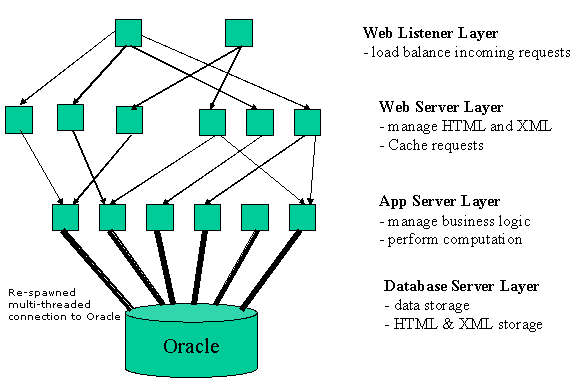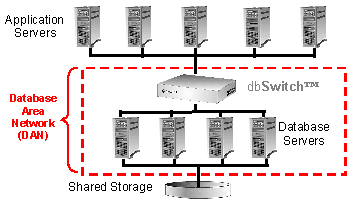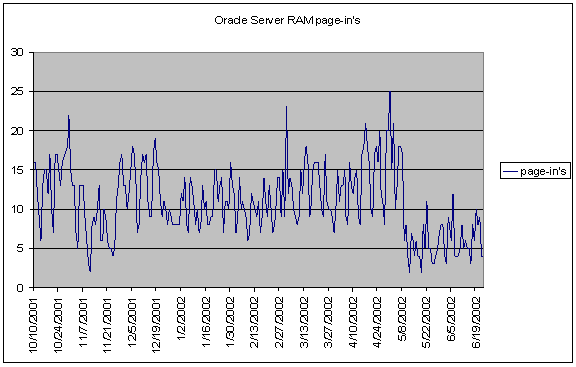Introducing Database Area Networks
Introduction
Corporations have invested millions of dollars in computing hardware. As a result, managing server resources has become extremely challenging. This article explores a new approach to Oracle technology that “virtualizes” the database layer, allowing for transparent relocation of Oracle database instances onto the most available servers, and enabling optimal utilization and just-in-time expansion of server resources. To fully comprehend the solution, you must first understand the problem.
The Problems of Dedicated Database Servers
Dedicated database servers are a boon to the DBA staff whose responsibility it is to maintain each server, but they present a challenge to IT management, as follows:
1) Expensive: In large enterprise data centers, hardware resources are deliberately over-allocated in order to accommodate processing-load peaks.
2) Wasteful: Because each Oracle instance resides on a single server, there is significant duplication of work, and a sub-optimal utilization of RAM and CPU resources.
3) Time Consuming: In many large Oracle shops, a “shuffle” occurs when a database outgrows its server. A new server is purchased, and the database is moved to the new server. Then the old server becomes available, and another database is migrated onto the old server. This shuffling of databases between servers is a huge headache for the Oracle DBAs who are kept busy after-hours moving databases to new server platforms.
The emerging Database Area Network (DAN) technology promises a solution to these problems.
The DAN Solution
The DAN concept has parallels in current large 4-tiered system architectures. Figure 1 illustrates how easily computing resources can be added at the Web server and application server levels. Large enterprises can add and remove application servers on a just-in-time basis, always ensuring that there are appropriate computing resources to match the load of their end-user community.

Figure 1: A typical 4-tiered server architecture.
In addition, the advent of Storage Area Networks (SAN) technology has made it easy to move disk storage from server to server, allowing the IT staff to dynamically relocate disk storage as needs change. While SAN has been highly successful for storage relocation, the database layer remains a serious system resource bottleneck.
With the exception of complex parallel architectures such as Oracle’s Real Application Clusters, database management systems can generally run on only one server at a time, and databases must be moved between servers manually. This limitation has led to a situation in which huge amounts of computer resources are wasted because of the difficulty of balancing server load at the database level.
To resolve this issue, research labs are exploring the concept of the Database Area Network, dubbed DAN. In the DAN architecture, a database switch is used with the underlying SAN to allow databases to move from server to server without affecting their availability.
The DAN technology promises the following benefits:
- Database Virtualization: Applications may access databases without being aware of the server that the databases are residing on at any given time.
- Database Server Consolidation: DAN technology can enable a dramatic reduction, often 50 percent or more, in the number of database servers, impacting immediate as well as deferred expenses for hardware, software, and administration. Hence, the Return on Investment (ROI) for a DAN can be swift.
- High Availability: If a server fails, the DAN quickly relocates the database to another server with minimal service interruption. This is a more affordable and far simpler solution than Real Applications Clusters or Oracle9i Data Guard, either of which requires duplicate servers.
- Scalability: Using DAN technology allows database servers to be seamlessly added for increased performance or removed for maintenance or upgrade, without interrupting service.
-
Centralized Management: DAN management provides a centralized view from which to control all database servers, and enables quick and easy relocation of database instances as processing demands change.
Reduced DBA Workload: DAN also reduces the maintenance time spent by DBAs. By consolidating server resources, the DBA has fewer servers to manage and need not be concerned with outgrowing their server. - Support for heterogeneity: In large enterprises, it is not uncommon to have many server platforms (e.g., HP/UX, Solaris, AIX, Linux) as well as database versions (Oracle 8i, 9i). In these environments, a single DAN can manage disparate database servers, yet guarantee that each database instance is relocated only within the appropriate set of servers matching its characteristics.
Let’s take a look at how a DAN achieves these benefits.
Inside the DAN Architecture
The DAN architecture achieves its flexibility by “virtualizing” the Oracle layer (refer to Figure 2). A high-speed database switch (dbSwitch™) is placed between the application layer and the database layer. This switch enables databases to be transparently relocated onto new servers without the need to modify applications connections to the database. The database servers, in turn, are connected to a shared storage such as SAN, such that database files can be quickly remapped onto a different server.
Using IP address masks enables virtualization of database addresses. To the database clients, each database is identified by a unique virtual IP address (VIP). These VIPs are not defined on any specific machine on the network, and are routable by the dbSwitch™ using Network Address Translation (NAT). This allows the DAN to move Oracle instances without affecting the application server layer.

Figure 2: The DAN architecture.
Traditionally, load balancing of database servers has been complex and problematic. Many companies waste millions of dollars each year by over-allocating database server resources. Worse yet, because they lack knowledge of and visibility into database resource utilization requirements and patterns, many enterprises also under-allocate server resources, forcing end users to endure unacceptable response times until the DBA can manually relocate the database to a larger server.
To address this inefficient use of database server resources, researchers are exploring DAN techniques to allow for the dynamic relocation of database instances, to optimally match server processing capacity to database resource requirements.
Dynamic Management of Oracle Server Resources
One exciting feature of a database area network is the promise of using intelligent algorithms to establish database usage patterns over time. By constantly polling the resource consumption metrics of databases, saving this history, and analyzing it, a DAN will be able to anticipate future problems and bottlenecks and take proactive actions to prevent a slow down.
The management console can advise the Oracle DBA of how best to arrange database instances on the servers, and further assist the DBA to perform database relocation.
It is important to note that the DAN technology is a Decision Support System (DSS) because it provides the Oracle DBA with both visibility into database resource usage (including current and historical charts) as well as recommendations for changes, deferring to the DBA for the final resolution.
The management console allows servers and databases to be easily added to and removed from the DAN. The combination of resource optimization and instance relocation allows the DAN to drive database servers with just the right level of utilization. This enables large enterprises to consolidate servers and realize dramatic savings in hardware, software licenses, and administration costs.
All savvy database professionals know that database servers develop well-known stress “signatures.” These signatures develop because of the periodic nature of the application (e.g., a billing application running on fixed billing cycles) or end-user processing (e.g. , eCommerce shopping picking up before holidays), and can be seen when server stress is plotted by the hour or the day, as shown, for example, in Figure 3. The DAN resource optimization algorithms use statistical techniques to identify and take advantage of these historical usage patterns, and can thus recommend the best “mix” of instances on database servers.

Figure 4: A server utilization signature.
As this technology matures, DANs will evolve to use historical metrics on CPU and RAM usage in order to predict when a database may experience stress, and proactively relocate the database to a more available server, just in time to accommodate the increased needs.
Let’s take a closer look at how DAN technology accomplishes database relocation between servers.
Database Relocation in the DAN
The internal mechanism for relocation may be quite complex, but the idea is simple. We'll start with a simple example using SAN. In a SAN environment, relocation of a database instance involves the following steps:
1. Shut down the database.
2. Un-mount the SAN data file systems from the source server, and then mount them on the target server.
3. Re-start the database on the new server.
4. Use the dbSwitch™ routing mechanism to redirect transactions accessing the database (VIP) to the new server.
A typical time for such relocation is 10 — 20 seconds. Using products such as Oracle’s Transparent Application Failover (TAF) may allow instance relocation to be performed such that the move to another server is transparent to the database clients and application end users.
Conclusion
The Oracle database load balancing enabled by DAN technology has important ramifications for the IT manager. With millions of dollars spent in hardware, the IT manager’s job is to maximize the utilization of expensive server resources while maintaining acceptable response time for the end users. Using a DAN to make intelligent database relocation decisions based on resource usage history can allow IT management to consolidate servers, saving millions of dollars each year in hardware costs and software licensing fees.
Any DBA with a SAN can move databases from server to server by running database and storage commands, with a few minutes of system downtime. When DAN technology is added, relocation can be done by pressing a button, and it can be completed in seconds using intelligent agents on the database servers, without losing transactions or breaking applications or end user sessions.
Of course, DAN technology is still in its nascent stage, and a few brave companies are exploring this new technology. It will be interesting to see how this exciting new technology evolves, and how quickly large data centers adopt the DAN technology and leverage it to achieve database server consolidation, resource optimization and high availability.
--
Donald K. Burleson is one of the world’s top Oracle Database experts with more than 20 years of full-time DBA experience. He specializes in creating database architectures for very large online databases and he has worked with some of the world’s most powerful and complex systems. A former Adjunct Professor, Don Burleson has written 15 books, published more than 100 articles in national magazines, serves as Editor-in-Chief of Oracle Internals and edits for Rampant TechPress. Don is a popular lecturer and teacher and is a frequent speaker at Oracle Openworld and other international database conferences. Don's Web sites include DBA-Oracle, Remote-DBA, Oracle-training, remote support and remote DBA.
Contributors : Donald K. Burleson
Last modified 2005-06-22 12:04 AM
